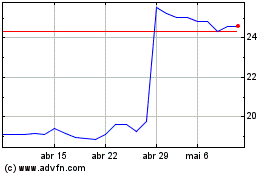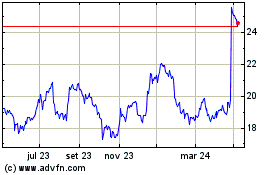Chinese companies have launched a record wave of foreign
acquisitions in the first few weeks of 2016 as they seek inroads
into overseas markets amid China's slowing economy and falling
currency.
China National Chemical Corp., known as ChemChina, on Wednesday
said it would pay $43 billion to buy Swiss pesticide maker Syngenta
AG in a deal that, if approved by Syngenta shareholders and
regulators, would be the largest foreign takeover by a Chinese
company.
Including the ChemChina deal, the combined value of China's
outbound mergers and acquisitions has reached about $68 billion so
far this year, the strongest volume ever for this period and
already more than half of 2015's record annual tally, according to
deal tracker Dealogic.
Other Chinese companies, such as Haier Group and China Cinda
Asset Management Co., have also been ramping up their foreign-asset
purchases in recent years as China looks to bolster its
capabilities in industries including agribusiness, real estate and
energy.
The flurry of deals is providing a jolt of attention to the
world's second-largest economy after the U.S. as it suffers from
its weakest growth in 25 years and its volatile stock market panics
investors globally.
Companies such as ChemChina that are run by China's
government—or state-owned enterprises—are among those buying. A
push by President Xi Jinping to boost overseas trade through the
"One Belt, One Road" initiative aims to open up new markets from
Central Asia to Europe for Chinese companies that previously
focused at home.
The policy, invoking the spirit of the old Silk Road trading
route between East and West, means government cash may be available
to help finance state-owned enterprises, or SOEs, wanting to buy
foreign assets.
But Chinese companies' purchase of foreign assets may come under
scrutiny at home, as the deals come at a tricky time for the
economy.
Beijing is stepping up efforts to halt a flood of money leaving
the country in response to the slowdown and a currency that has
fallen 5.5% against the U.S. dollar since August. China's latest
efforts involve curbing the ability of foreign companies in China
to repatriate earnings and banning yuan-based funds for overseas
investments, people with direct knowledge of the matter have
said.
The Chinese government's concern over capital outflows—which may
have been as high as $1 trillion last year, by some estimates—may
mean that regulators in Beijing look more closely at certain
acquisitions of foreign assets, analysts said. But the government
will still likely support foreign deals that are seen as a
cornerstone of Chinese companies' overseas expansion, they
said.
"It's the nature of the assets that determines Beijing's
support," said Derek Scissors, resident scholar at the American
Enterprise Institute, a Washington-based think tank.
Chinese acquisitions of key Western technologies are likely to
face stiff scrutiny overseas.
In the U.S., a federal agency that screens corporate takeovers
for security concerns recently nixed a deal by a Chinese investment
fund to buy the lighting business of Royal Philips NV. The business
had manufacturing, research and development facilities in the
U.S.
The agency, the Committee on Foreign Investment in the U.S., is
likely to look closely at the ChemChina-Syngenta deal because most
of Syngenta's seed business is in the U.S.
Overall, "we see the deals getting bigger and bigger," said
Patrick Yip, mergers and acquisitions leader for Deloitte China,
referring to Chinese companies' acquisitions of foreign companies.
"I am working on a number of them. Chinese companies want brand
power and high technology."
David Brown, transaction services leader for
PricewaterhouseCoopers China and Hong Kong, predicts around 50%
growth for outbound Chinese mergers and acquisitions every year,
for the next several years.
There is "huge pent-up demand," said Mr. Brown, as Chinese
companies gain confidence to pursue global deals.
The depreciation of the yuan—and the expectation that it will
continue falling—means that Chinese companies are looking to buy
now before the price of foreign assets gets more expensive, said
Rocky Lee, a Beijing- and Hong Kong-based partner at law firm
Cadwalader.
China's yuan, after strengthening by more than 30% over the past
decade, has fallen 8% against the U.S. dollar since the beginning
of 2014 as policy makers seek to make their currency more
market-driven and grapple with a deepening economic slowdown.
Some analysts believe the yuan could fall up to 10% more by the
end of this year amid fears that the Chinese economy is slowing
faster than expected and as the government's moves to contain
market forces send capital flooding out of China.
Chinese state-owned enterprises, for one, are receiving strong
backing for strategic foreign acquisitions from the central
government.
"A lot of the [state-owned enterprises] are fairly cash-rich,"
says Ben Cavender, a Shanghai-based principal at China Market
Research Group. "One of the issues they're running into is they're
out of room to grow in their home market."
ChemChina, when it agreed to buy Italian premium tire maker
Pirelli & C. SpA for roughly $7.7 billion last year, had
secured funding from an overseas investment vehicle championed by
China's president.
Under the deal, Silk Road Fund Co.—an investment vehicle
controlled by China's State Administration of Foreign Exchange and
other state-owned entities—took a 25% stake in the ChemChina
subsidiary set up to acquire Pirelli's shares.
The government is likely to continue providing financial support
for SOEs to buy foreign assets in areas such as technology, energy
and infrastructure, said Mr. Lee of Cadwalader.
Brian Spegele and Anjani Trivedi contributed to this
article.
Write to Kathy Chu at kathy.chu@wsj.com and Julie Steinberg at
julie.steinberg@wsj.com
(END) Dow Jones Newswires
February 03, 2016 14:15 ET (19:15 GMT)
Copyright (c) 2016 Dow Jones & Company, Inc.
Koninklijke Philips NV (EU:PHIA)
Gráfico Histórico do Ativo
De Mar 2024 até Abr 2024

Koninklijke Philips NV (EU:PHIA)
Gráfico Histórico do Ativo
De Abr 2023 até Abr 2024
